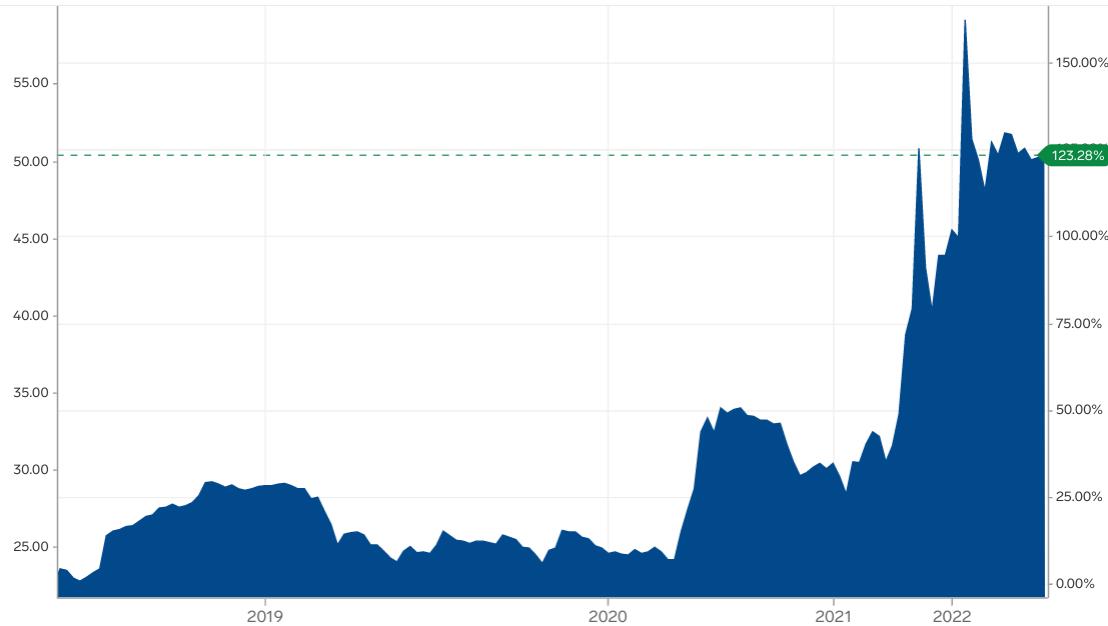
2 minute read
Private Wealth Management
Champions
The foregoing is a natural lead-in to re-recommending one of my favorite natural resources: uranium. As you can see below, it has been bouncing around the $50/ pound level for most of the last two years. Yet, that’s not nearly high enough to incentivize new uranium mines.
Uranium Prices: Five-Year Chart
Markets Insider
Uranium Prices: Sixteen-Year Chart
Markets Insider
For over a decade, that didn’t matter because there was a major oversupply of U-92 in the wake of the Fukushima disaster. Japan closed over 40 reactors as a result of it, eliminating 13% of global demand nearly overnight. As more countries, especially Germany, turned against nuclear after the catastrophe, uranium prices gradually eroded down to $18 per pound. This was down 75% from the pre-Fukushima level and off over $100/pound from the 2007 peak. As a result, hundreds of producers shut down operations.

Decommissioned nuclear warheads the megatons-to-megawatts program that began after the former USSR disintegrated also amplified the glut. The persistence and magnitude of the excess supply bred complacency among the primary consumer of U-92, the global utility industry.* Aggravating the supply/demand imbalance, a plethora of nuke power plants were shut down post-Fukushima in Western countries.
Today, it is a radically different story. There are 60 new nuclear reactors under construction, over one-third of them in China. Hundreds of others are in the design stage. Moreover, scheduled de-commissionings of existing plants are being postponed and some shuttered facilities are coming back online. Uranium inventories were already dangerously depleted prior to this sudden nuclear renaissance. This has created upside price pressures, but virtually every expert I have read or listened to believes they need to go much higher from here to stimulate new output.
Further aggravating this is the momentum that is building around SMRs. These, of course, require uranium. (Thorium is another potential fuel source, as noted above, but it appears many years, if not decades, away from being widely used, also based on what I’m hearing from the pros.) In essence, there is a high probability of an acute shortage of uranium and a vertical move in prices. Perhaps it won’t be the tenfold increase seen by lithium in 2021 and 2022, but it has the potential to be extremely rewarding to uranium miners and investors.
There are a number of publicly traded uranium mining stocks but they look expensive to me right now, unlike with other natural resources producers, like copper, oil, and natural gas. An interesting ETF exists that provides a convenient way for retail investors to play the resurgent demand for U-92, but you’ll need to look that up on your own due to SEC restrictions. From the time of its formation in the summer of 2021, it has been a steady buyer whenever the price dipped. This is helping to put a floor under the prices of spot market uranium.
If I’m right that molten salt nuclear reactors are on the verge of their AI moment, uranium will almost assuredly go along for the ride. Even if I’m wrong, there are plenty of upside catalysts for U-92. But it’s always nice to have a kicker, especially one that could go nuclear.. literally.
*From a friend and legitimate nuclear expert:
It is mined as uranium ore. Then, generally on the same location, it is milled, or rather crushed and ground up, until the desired size is reached. Then chemicals are used to separate the uranium. It’s mostly U235 at that point it is called “yellowcake”. At that point, it’s over 99% Uranium 235. From yellowcake it goes through a process of separation to obtain U235 for fission reactors. U235 makes up around 0.72% of that Uranium.
That is made into fuel for reactors. That is called the front end of the nuclear fuel cycle.

